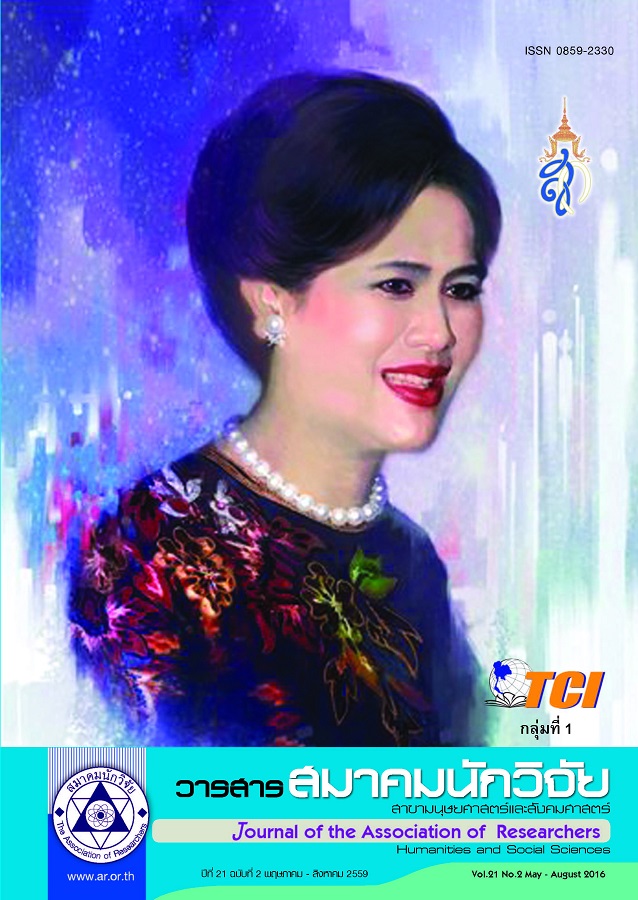Perceptions of Individual – Level of Organizational Culture and Knowledge Management Influencing on Innovations within KTIS Group
Main Article Content
Abstract
The purposes of this research were to 1) study the relationship among perceptions of individual – level of organizational culture, knowledge management, and innovations of KITS Group; and 2) examine the consistency between the structural equation model and empirical evidence; and 3) study the influences of individual – level of organizational culture and knowledge management on innovations of KITS Group. Sample group consisted of 233 members of the KTIS Group Innovative Program obtained from a simple random sampling. Data was analyzed by Pearson correlation coefficient, considering the consistence between the model and fit indices and using path analysis. It was found, from the research findings, that 1) correlation among observed variables were 0.276-0.694 2) the structural equation model perceptions of individual – level of organizational culture and knowledge management influencing on innovations within KTIS Group is in harmonious with the fit indices with Chi-square = 45.70, df = 34, χ2/df =1.34, P-value = 0.086, RMSEA =0.059, CFI = 0.99 2), organizational innovation is influenced directly by knowledge management (DE=0.57, p < 0.05) and
organizational culture (DE=0.26, p < 0.05) and also indirectly by organizational culture (IE = 0.44, p < 0.05) through knowledge management, with the results of this research indicating that all of the variables can predict 50% of a dependent variable (KTIS Group Innovation) with significant level of .05
Article Details
บทความที่ปรากฏในวารสารนี้ เป็นความรับผิดชอบของผู้เขียน ซึ่งสมาคมนักวิจัยไม่จำเป็นต้องเห็นด้วยเสมอไป การนำเสนอผลงานวิจัยและบทความในวารสารนี้ไปเผยแพร่สามารถกระทำได้ โดยระบุแหล่งอ้างอิงจาก "วารสารสมาคมนักวิจัย"
References
References
Aujirapongpan, Sonmnuk. et al. (2011). “Knowledge management capability and innovative entrepreneurs in Thailand.” NIDA Development Journal. 51 (1): 157-167. (in Thai)
Barst, J. and Capozzi, M. and Davidson, J. (2008). “Leadership and innovation.” The McKinsey Quarterly. No.1: 24-35.
Blayse, A. M. and Manley, K. (2004). “Key influences on construction innovation.” Construction Innovation. Vol.4 No.3: 54-143.
Beesley, L., and Cooper, C. (2008). “Defining knowledge management (KM) activities: Towards consensus.” Journal of Knowledge Management. 12 (3): 48-62.
Carneiro, A. (2008). “When leadership means more innovation and development.” Business Strategy Series. 9 (4): 176-184.
Cameron, K.S. and Quinn, R.E. (2011). Diagnosing and changing organization culture. San Francisco, CA: John Wiley & Sons.
Chen, Derek H.C. and Dahlman, C.J. (2005). “The knowledge economy, the KAM methodology and world bank operations.” World Bank Institute Working Paper. No. 37256: 35.
Dobni, C. B. (2006). “Developing an innovation orientation in financial services organizations.” Journal of Financial Services Marketing. Vol.11 (2): 171.
Dovey, K. (2009). “The role of trust in innovation.” The Learning Organization. Vol.16 No.4: 311-325. Eaton, D. and Akbiyikli, R. and Dickinson, M. (2006). “An evaluation of the stimulants and impediments to innovation within PEI/PPP projects.” Construction Innovation. Vol.6 No.2: 63-77.
Holbeche, L. (2005). The high performance organization. Oxford. Printed by Great Britain.
Isaksen, S. and Tidd, J. (2006). Meeting the innovation challenge: leadership for transformation and growth. New York. Wiley. NY.
Jarvenpaa, S. L. and Staples, D. S. (2001). “Exploring perceptions of organizational ownership of information and expertise.” Journal of Management Information Systems. Vol. 18 No.1: 83-151.
Kline, R.B. (1998). Principles and practice of structural equation modeling. New York: Guild Press.
Krejcie R.V. and Morgan, D.W. (1970). “Determining sample size for research activities.” Journal of Education and Pnychological Measurement. (3): 607-610.
Laudon, K.C. and Laudon, J.P. (2006). Management information systems: Managing the digital firm. Singapore: Pearson Education Indochina. North, D. and Smallbone, D. 2000. The Innovativeness and Growth of Rural SMEs During the 1990s. Regional Strudies. 34, 2: 57-145.
Oh, E. (2007). Project organization, diverse knowledge, and innovation systems in the Korean game software industry. Doctor of Philosophy. School of Public Policy. Panuwatwanich, K. and Stewart R. A. and Mohamed, S. (2008). “The role of climate for innovation in enhancing business performance.” Engineering Construction and Architectural Management. Vol. 15 No. 5: 407-422.
Ringland, G. (2008). “Innovation: scenarios of alternative futures can discover new opportunities for creativity.” Strategy & Leadership. 36 (5): 22-27.
Robbins, S. P. (1990). Organization theory: structure designs and application. New Jersey, Prentice-Hall lnc.
Stamm, B. Von. (2009).“Viewpoint leadership for innovation: what you can do to create a culture conducive to innovation.” Strategic Direction. Vol. 25 No. 6: 13-15.
Steiger, J.H. (1990). “Structural model evaluation and modification: An internal estimation approach,” Multivariate Behavioral Research. 25 (2): 173-180.
Tsai, (2001). “Knowledge transfer in intra organizational networks: effects of network position and absorptive capacity on business unit innovation and performance.” Academy of Management Journal. 44 (5): 996-1000.
Ullman, J.B. (2001). “Structural equation modeling.” In B.G. Tabachnick, and L.S. Fidell. Using Multivariate Statistics, (4thed.), 653-771. New York: Allyn& Bacon.
Zheng, C. (2009). A correlational study of organizational innovation capability and two factors: innovation drivers and organizational culture. Doctor of Management in Organizational Leadership. University of Phoenix.


